Valley of the Temples Travel Guide
Affiliate disclosure: some of the links in this article are affiliate links. If you book using one of them, we’ll earn a small commission. All of our info is free to read and free of ads, so we appreciate it!
The UNESCO-listed Valle of the Temples is the heart of the once-great ancient Greek city of Akgragas. It was one of the most prominent cities in the area known as Magna Graecia (Greater Greece) whichover much of southern Italy.
Founded in the 6th century BC by Greek settlers from the nearby Gela (south of Agrigento), Akragas became a leading Mediterranean city with a population of more than 300,000 people, rivaling Carthage and Syracuse for importance.
Its honey-colored temples still dominate the valley, having stood there for over 2,500 years. They also are the best preserved Doric temples outside of Greece.
This Greek city experienced great prosperity during the time when the temples were erected, contributing to its fame. Unfortunately, in 406 BC it was attacked by the Carthaginians, then defeated by the Romans in 210 BC, after which it lost its primacy forever. Its treasures were not rediscovered until the 19th century, when the archaeologist Domenico Antonio Lo Faso Pietrasanta uncovered them.
Table of Contents
Valley of the Temples planning cheatsheet
 Plan your itinerary with expert advice
Plan your itinerary with expert advice
- Book a Sicily travel consultation with a local expert
 My favorite hotels near Valley of the Temples (Agrigento)
My favorite hotels near Valley of the Temples (Agrigento)
- Doric Eco Boutique - luxurious countryside hotel overlooking the ruins. $300/night
- Villa Lekythos - Modern bed & breakfast with a great garden and pool. $175/night
- B&B Triskéles - charming guesthouse with a wonderful terrace. $150/night
- Locanda degli Scrittori - good value option on the edge of town. $110/night
- Terazze di Montelusa - pleasant B&B in the center of Agrigento. $90/night
 Guided tours and activities
Guided tours and activities
 How to get around
How to get around
- Car rentals with DiscoverCars
- Train tickets from Trenitalia
- Bus routes at Flixbus, SAIS, and BusBud


Why visit?
Extending over 1,300 hectares, the Valley of the Temples is one of the largest archaeological sites in the world. Along with Pompei, it is the most impressive testimony of the ancient world in Italy. On a visit here, you will literally walk through history while exploring the gold-hued temples dotting a green valley full of almond and olive trees.
The site consists of eight stunning temples, along with many other remains, such as necropolises and sanctuaries. They are among the finest testaments to the Greeks and one of their best preserved archaeological sites.
Some go so far as to consider the site second only to the Acropolis of Athens due to its importance! No doubt, it will make archeology lovers jump for joy.
Where is the Valley of the Temples?
Photo: Hel-hama, CC BY-SA 3.0, via Wikimedia Commons
The Valley of the Temples is located just outside the modern city of Agrigento, about 3 km away. It lies along the center of the southern coast of Sicily, overlooking the intense blue Mediterranean Sea. Palermo is 122 km to the north, while Trapani lies 155 km to the northwest.
Despite its name, the site is not actually a valley as it stands on a ridge about 230 meters above sea level, majestically overlooking the surrounding countryside. It offers a formidable sight, as the temples are scattered amongst olive and almond trees.
How to get here
Palermo to Agrigento - by train and bus
You can reach Agrigento from Palermo by catching the train, which has regular daily departures from 6 am to 8 pm. One-way tickets cost €9 and the ride takes 2 hours. Once arrived in Agrigento, the local buses to the Valley of the Temples depart from Piazza Rosselli, just 500 meters from the railway station. Buy tickets at Trenitalia.
Otherwise, you can take the bus from Palermo to Agrigento (Autoservizi Cuffaro, departures from 8 am to 6 pm). One-way tickets cost €12 and the journey takes around 2.5 hours. The bus arrives at Piazza Rosselli, from where you can then catch the local bus to the temples (TUA lines 1, 2, 3).
Another company, F.lli Camilleri Argento & Lattuca S.r.l, also has daily scheduled departures between Palermo and Agrigento.
Bus from Agrigento to the Valley of the Temples
From Agrigento, bus Line 1 departs every 30 minutes and takes 20 minutes to reach Porta V, the western entrance to the Valley of the Temples. Along the way, it stops at the archaeological museum.
Line 2 runs basically equally frequently and stops at Porta Giunone, the eastern entrance.
Line 3 runs less frequently and leaves you in the middle of the path along the Valley.
One-way tickets for all the lines cost €1.70 and you can buy them in advance from a kiosk next to the bus stop or on board the bus. Always remember to validate your tickets when you board.
On foot (from Agrigento)
If you like to walk, you can also reach the temples on foot. They are just 3 km from Piazza Rosselli in central Agrigento. It is an easy walk downhill and you can see the valley from the road, catching a stunning glimpse of just how big it is.
By car
As always in Sicily, having a car is best. From Palermo and Trapani, the Valley of the Temples is a little over 2 hours away. If coming from eastern Sicily, the Temples are just under 2 hours from Catania, for example. To get here from any of those cities, you will be traveling along well maintained state roads.
Once you arrive to the archaeological site, you’ll find parking lots at the entrances at Porta V and Porta Giunone. The parking fee is €2 for the first hour, €1 for the second hour, then €0.50 for every following hour. You will pay a maximum rate of €5 per day.
If you’re planning on renting a car, I’d recommend checking prices on DiscoverCars.It’s a car rental website that includes offerings from all the major international rental companies as well as lots of smaller local agencies, which often have much better pricing. You can often find great deals.
By guided tour
For those staying in places like Palermo and Trapani, you have plenty of options for day trips that visit Valley of the Temples. Because it’s a far journey, most tours are full-day and will also include a stop in town in Agrigento and at the Scala dei Turchi cliffs.
If you’re staying in Agrigento (or elsewhere) and getting to the temples on your own, you can also book a walking tour of just the archaeological complex. Most guided tours are 2-3 hours.
Here are some good tour options:
Logistics of visiting
Opening hours
The site is open daily from 8:30 am to 7:00 pm. From mid-July to mid-September, the opening hours extend to 11 pm during weekdays and till midnight on weekends. By night, you can see the temples illuminated.
Admission tickets
Admission tickets for most adults cost € 12 per person, or €6 if you are an EU citizen aged 18-25 (you’ll need to show your ID). Children under 18 years old are free. English audioguides are available for €5.00 at the ticket desk.
For a comprehensive visit, you can purchase a combo ticket that includes the Kolymbetra Garden (€18) or the archaeological museum (€16.80).
Buy the tickets in advance via the official Coop Culture website (the same one used for Vatican entrance tickets in Rome) if you want to avoid lines at the ticket office. On-site, tickets can be purchased at either the western or eastern entrance.
Every first Sunday of the month, entrance to the site is free for everyone.
Guided tours
You can visit the site independently or join a scheduled guided tour starting from the Porta Giunone ticket office. Group tours depart every day from 10:45 am to 5:15 pm and cost €20 per person in addition to the entrance fee.
Alternatively, you can hire a private guide. In summer, you can opt for a guided tour by electric scooter (1 or 2 hours, € 55-75 per person, two persons minimum). The driving is easy and your guide will lead you around the park, answering your questions the whole way. Arrive early, as there are not many electric scooters available.
Another option is to visit the Valley of the Temples at sunset, joining a sunset tour at 5:00 pm. From mid-July to mid-September, you can join an evening tour, starting at 6:30 pm and ending at 9:00 pm.
Which entrance: eastern or western?
There are two entrances to the Valley of the Temples: Porta Giunone is the eastern entrance, while Porta V is the western entrance. Technically, it doesn’t matter from where you start the visit, but since the path to Porta Giunone is downhill, many people prefer to start from there.
Wherever you choose to start, you can return to the parking lot by retracing your steps or taking the small electric shuttle (similar to a golf cart) that takes you back up for €3. If you plan to arrive late in the morning, be aware that the western entrance has more parking spaces.
Best time of day to visit
If you can, try to visit the site early in the morning. It will be less hot and less crowded, as the tourist buses will not have arrived yet and the peak heat of midday will still be a long ways off.
Alternatively, consider visiting the valley in the late afternoon or evening. The heat will be less stifling, the tour buses will likely have departed by then, and you will undoubtedly enjoy seeing the illuminated temples at night.
If you are visiting Sicily during the summer, be prepared for the heat. Wear a hat and bring lots of sun cream as inside the archaeological park, there is next to no shade. Avoid exploring it in peak sunshine hours (about 12:00 to 3:00 pm).
Along the path, you'll find some water fountains where you can grab a drink or fill up your bottle, and in the eastern zone, there’s a cafe where you can stop to relax and grab something to eat and drink.
How long does a visit take?
The site extends over a much larger area than you’re probably expecting and a visit involves walking about 4-5 km of walking. With that in mind, you should budget about 3-4 hours to see the entire site.
From one entrance to the other is about 2 km, but you will inevitably deviate from the path here and there to see the attractions. Then, after you’ve seen everything, you'll need to retrace the route backwards to return to your car.
Main sights
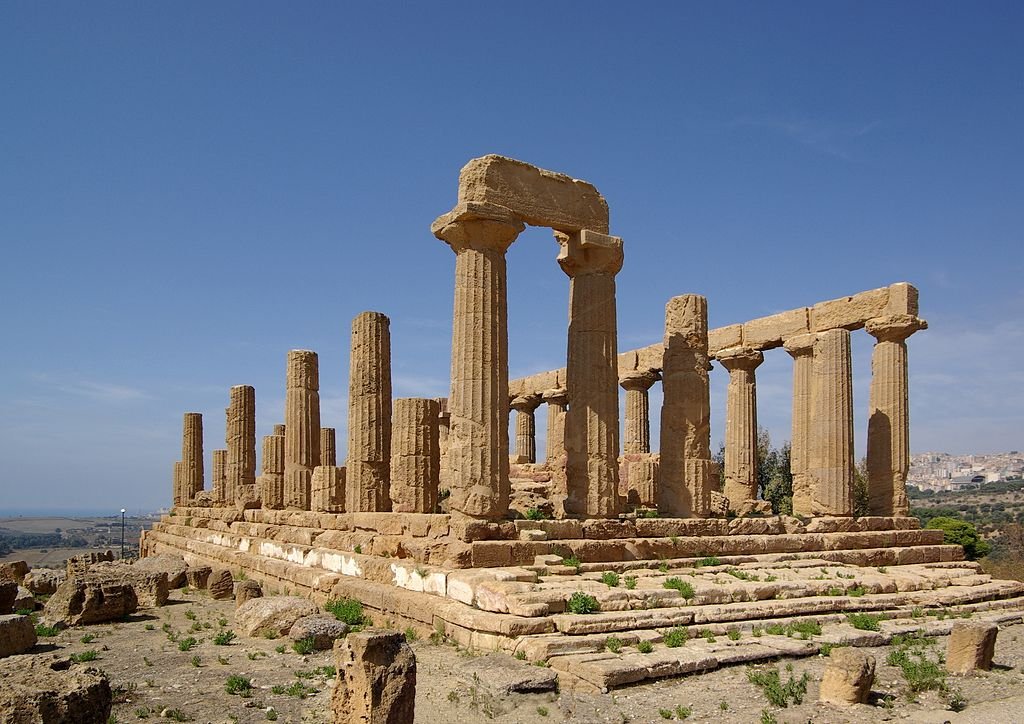

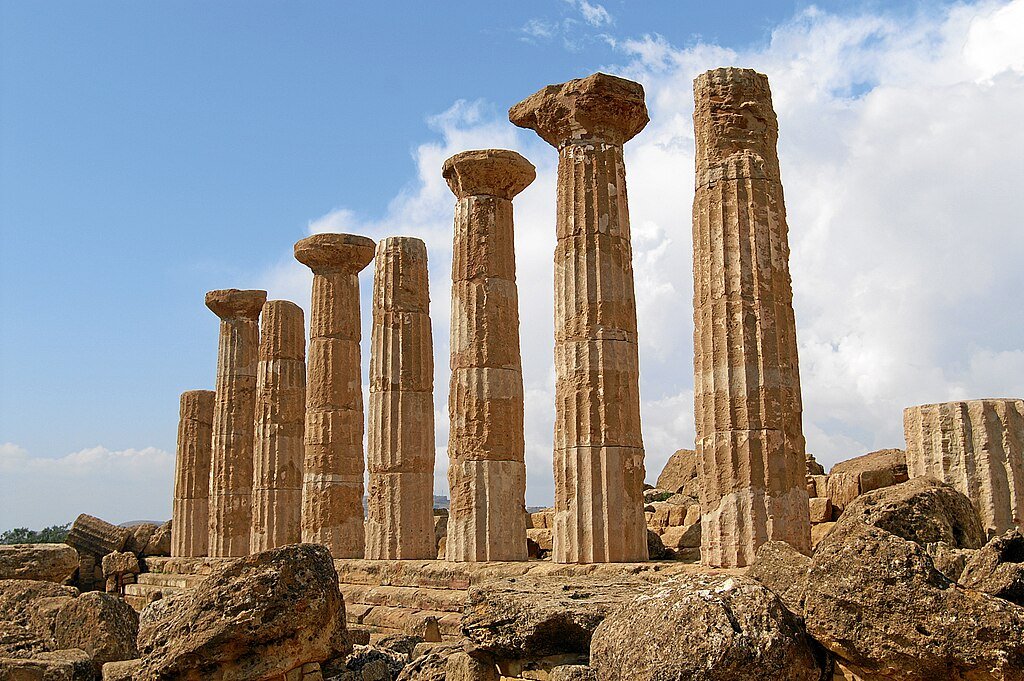
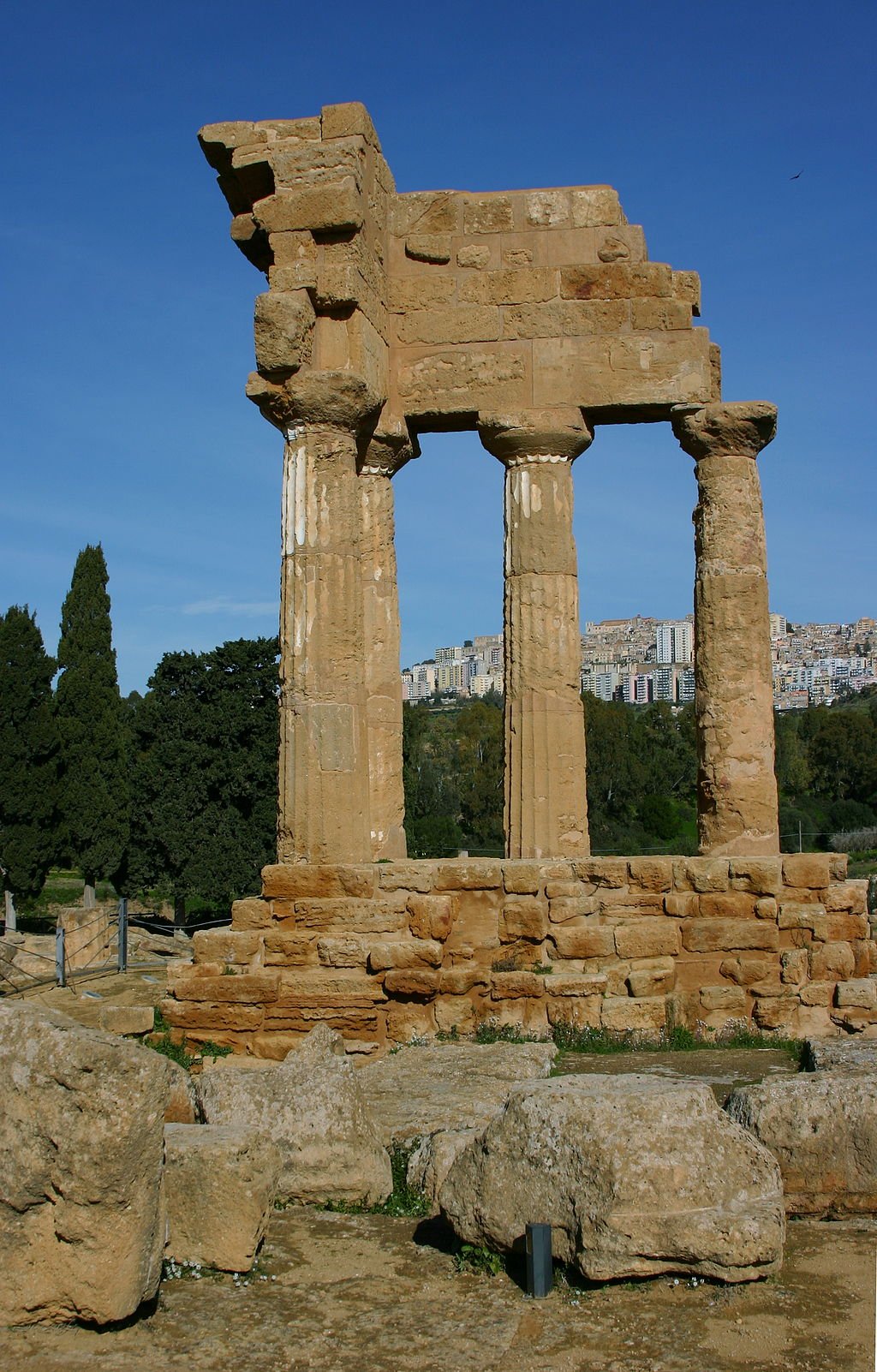
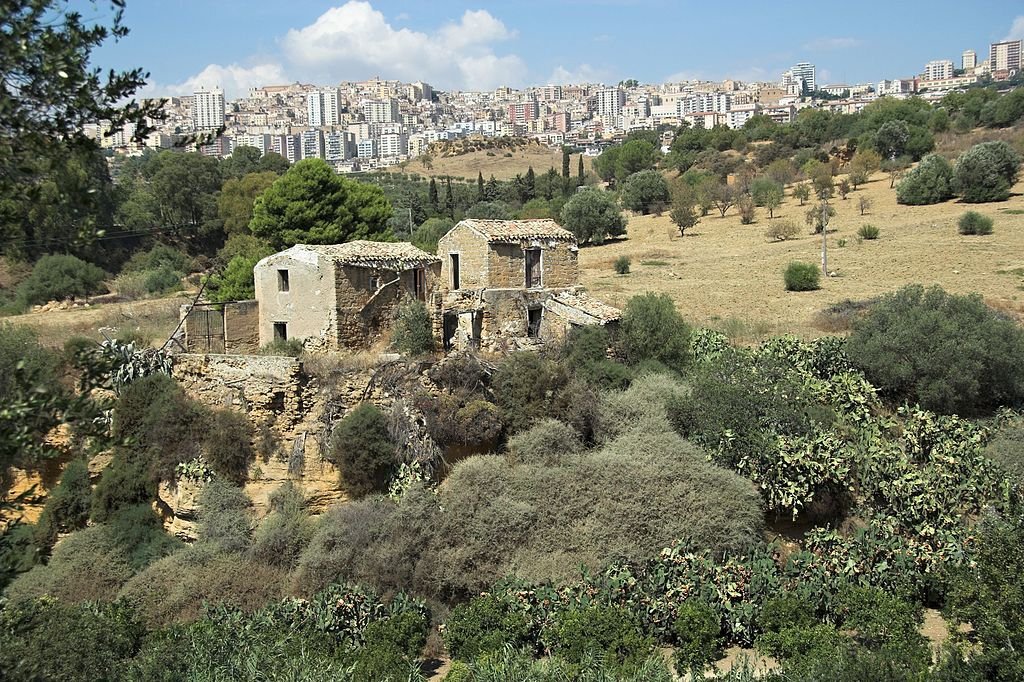
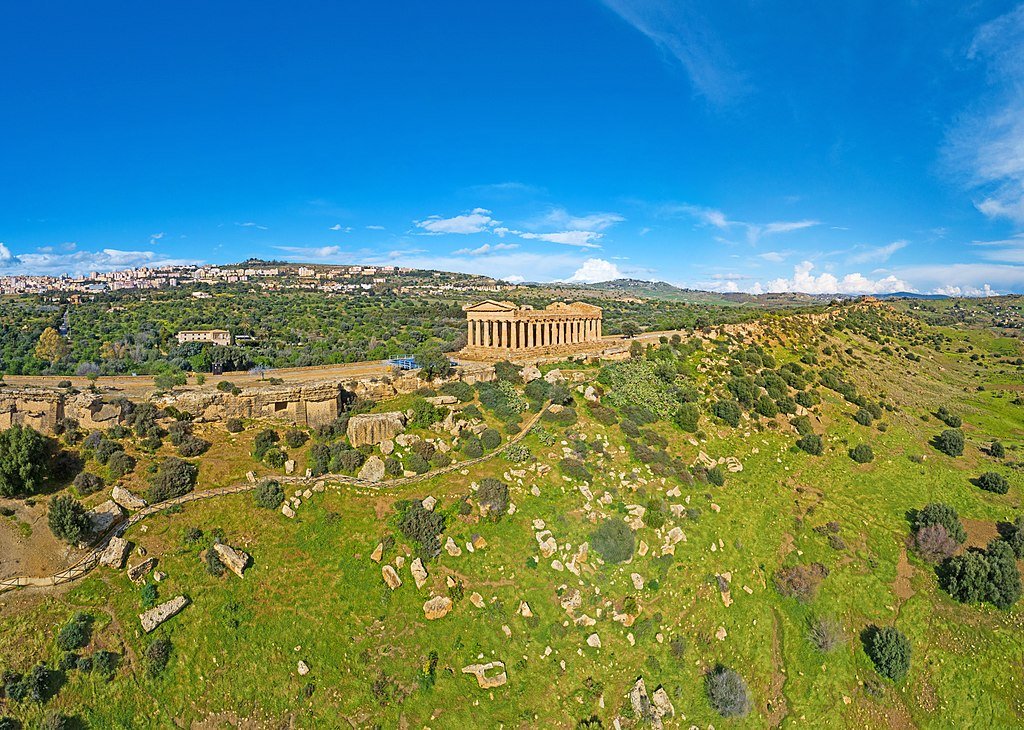
Temples in the eastern zone
The best-preserved temples lie in the eastern zone. Hera Temple (or Juno Temple) was dedicated to Zeus’ wife. It was burned down by the Carthaginians in 406, but it was reconstructed.
The stunning Temple of Concordia, dedicated to the goddess of harmony and unity, was built in the 5th century BC. It is very well-preserved as it was consecrated as a Christian basilica in the 6th century AD.
The Temple of Heracles, of which only eight columns remain, is considered the oldest temple on the site.
Temples in the western zone
The western zone is home to the imposing Temple of Zeus, destroyed by the Carthaginians before being completed. It could have been the greatest Doric temple in the entire West.
The Temple of the Dioscuri (Castor and Pollux) and a Sanctuary dedicated to the goddesses Demetra and Kore lie in the same area.
In addition to the temples, you can also see late-Roman and Byzantine necropolises, ancient residential areas, and the lush Kolymbetra garden, once a Greek pool and now home to a wide variety of exotic and indigenous plants.
Valley of the Temples itinerary
For this itinerary, I would suggest starting from the eastern entrance at Porta Giunone. Pass through the security check and proceed straight to the ticket office (unless you’ve already booked your tickets online).
Once you’ve entered the site, your first stop is the Hera Temple, immediately followed by the superstar of the Valley of the Temples, the amazing Temple of Concordia. You cannot go inside, so just admire its perfectly preserved exterior and the imposing Doric columns. At its base, you can see the Fallen Icarus by the Polish artist Igor Mitoraj. The bronze statue, lying legless and wingless, was part of an exhibition that took place here in 2011.
Continue west along the main road. You’ll pass by Villa Aurea, a 19th-century villa where the British archaeologist Alexander Hardcastle, who financed the reconstruction of many temples, lived between 1925 and 1932. You can stroll around a small garden on the premises of the villa to take a break from the scorching heat. There’s also a water tap to refill your bottle.
Next up, you’ll stumble upon the Temple of Heracles, located on a rocky spur near the Villa Aurea. From here, you can see the city of Agrigento standing atop a ridge.
Continuing further down, you will find a bridge connecting the eastern and the western zones. Right off the bridge, you’ll see the Altar of the Temple of Zeus. Next to it is the Temple of Zeus, one of the largest ancient Greek temples in the world. Explore the ruins thoroughly to see the three fallen statues.
As you continue through the western side, you will reach the Temple of Dioscuri, also known as the Temple of Castor and Pollux, twin brothers according to Greek mythology. The size of the temple is massive, but not much remains today except for the foundation and a few columns.
Next to the temple is the Kolymbetra garden, which is a lovely green space that can be visited if you’ve purchased a combined ticket. At this point, you will have reached the end of the path, and have essentially completed the sightseeing portion of your visit.
If you drove here and parked your back back on the eastern side at Porta Giunone, you can now retrace your steps back to the parking lot. Alternatively, if you took the bus or are getting picked up by someone else, continue along a path through the tunnel that leads to the western entrance, where you will find the parking lot and the bus stop to take you to Agrigento.
A few final tips
Stick to the route: It is forbidden to walk over the temple grounds but there aren’t many attendants around the park, so it’s visitors’ responsibility to respect the site, avoiding touching the ruins, statues, and temples.
Get a map of the grounds: Unlike in other sites in Sicily, a map/written guide is not provided here. You can buy one at the souvenir shops next to the entrances for €1 or can get a digital one (find it here). You may need the map and corresponding written explanations as there aren't many explanatory panels around the park.
Photographs: Visit the site as early as you can in the morning if you want the best light for photography (most of the temples face east). Remember that tripods are not allowed.
Where to stay
If you’ll be staying overnight in the area, most accommodation options are in the nearby city of Agrigento or the surrounding countryside.
In Agrigento, I usually recommend staying at a hotel on or around Via Atenea, north of the train station, in the city center. Parking is usually not an issue here, but if you’ll have a car and want to be sure you’ll have easy, private parking, there are plenty of nice little B&Bs in the countryside on the edge of town.
If you choose to stay overnight, here are two reasonably priced hotels in town that I always recommend:
B&B Triskéles has a very boutique feel with a bit of old world charm and unique decorations. Breakfast is served on their gorgeous rooftop, with views overlooking Valley of the Temples and the sea. Nightly rates are around $150 USD.
Terrazze di Montelusa is hosted in an old palace with original furniture. Many rooms have lovely terraces with nice views. Rooms are usually $80-120 USD
If you want to stay on the edge of town, I recommend the following hotels:
Villa Lekythos just outside of town is a lovely property with comfortable, modern rooms, a gorgeous pool, and a relaxing garden. It puts you a quick drive from both the city and the beach. Rooms from $100 - 200 USD. It’s also family-run.
Locanda degli Scrittori is a nice choice if you prefer quieter accommodation. Rooms are housed in a modern country house on the outskirts of the city, surrounded by a lush garden. Nightly rates from $100 USD.
For a once-in-a-lifetime experience, you could also look at two luxury hotels in the countryside outside of Agrigento, both of which offers stunning views over the Greek ruins of Valley of the Temples.
Villa Athena is an ultra high-end option with rooms from $600 and up.
Doric Eco Boutique is gorgeous, but not quite as luxurious. Rooms from around $300 a night.


More Sicily travel info
For more advice on planning your trip to Sicily, check out some of our other guides and itineraries!
Regional info
City guides
Archaeological sites
Islands & nature
Tours

Connect with a Local Expert










